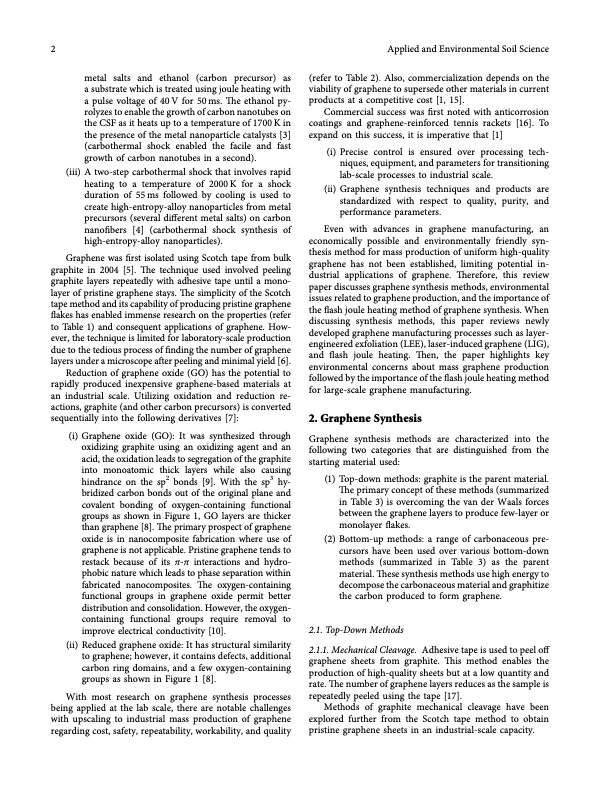
PDF Publication Title:
Text from PDF Page: 002
2 Applied and Environmental Soil Science metal salts and ethanol (carbon precursor) as a substrate which is treated using joule heating with a pulse voltage of 40 V for 50 ms. Te ethanol py- rolyzes to enable the growth of carbon nanotubes on the CSF as it heats up to a temperature of 1700 K in the presence of the metal nanoparticle catalysts [3] (carbothermal shock enabled the facile and fast growth of carbon nanotubes in a second). (iii) A two-step carbothermal shock that involves rapid heating to a temperature of 2000K for a shock duration of 55ms followed by cooling is used to create high-entropy-alloy nanoparticles from metal precursors (several diferent metal salts) on carbon nanofbers [4] (carbothermal shock synthesis of high-entropy-alloy nanoparticles). Graphene was frst isolated using Scotch tape from bulk graphite in 2004 [5]. Te technique used involved peeling graphite layers repeatedly with adhesive tape until a mono- layer of pristine graphene stays. Te simplicity of the Scotch tape method and its capability of producing pristine graphene fakes has enabled immense research on the properties (refer to Table 1) and consequent applications of graphene. How- ever, the technique is limited for laboratory-scale production due to the tedious process of fnding the number of graphene layers under a microscope after peeling and minimal yield [6]. Reduction of graphene oxide (GO) has the potential to rapidly produced inexpensive graphene-based materials at an industrial scale. Utilizing oxidation and reduction re- actions, graphite (and other carbon precursors) is converted sequentially into the following derivatives [7]: (i) Graphene oxide (GO): It was synthesized through oxidizing graphite using an oxidizing agent and an acid, the oxidation leads to segregation of the graphite into monoatomic thick layers while also causing hindrance on the sp2 bonds [9]. With the sp3 hy- bridized carbon bonds out of the original plane and covalent bonding of oxygen-containing functional groups as shown in Figure 1, GO layers are thicker than graphene [8]. Te primary prospect of graphene oxide is in nanocomposite fabrication where use of graphene is not applicable. Pristine graphene tends to restack because of its π-π interactions and hydro- phobic nature which leads to phase separation within fabricated nanocomposites. Te oxygen-containing functional groups in graphene oxide permit better distribution and consolidation. However, the oxygen- containing functional groups require removal to improve electrical conductivity [10]. (ii) Reduced graphene oxide: It has structural similarity to graphene; however, it contains defects, additional carbon ring domains, and a few oxygen-containing groups as shown in Figure 1 [8]. With most research on graphene synthesis processes being applied at the lab scale, there are notable challenges with upscaling to industrial mass production of graphene regarding cost, safety, repeatability, workability, and quality (refer to Table 2). Also, commercialization depends on the viability of graphene to supersede other materials in current products at a competitive cost [1, 15]. Commercial success was frst noted with anticorrosion coatings and graphene-reinforced tennis rackets [16]. To expand on this success, it is imperative that [1] (i) Precise control is ensured over processing tech- niques, equipment, and parameters for transitioning lab-scale processes to industrial scale. (ii) Graphene synthesis techniques and products are standardized with respect to quality, purity, and performance parameters. Even with advances in graphene manufacturing, an economically possible and environmentally friendly syn- thesis method for mass production of uniform high-quality graphene has not been established, limiting potential in- dustrial applications of graphene. Terefore, this review paper discusses graphene synthesis methods, environmental issues related to graphene production, and the importance of the fash joule heating method of graphene synthesis. When discussing synthesis methods, this paper reviews newly developed graphene manufacturing processes such as layer- engineered exfoliation (LEE), laser-induced graphene (LIG), and fash joule heating. Ten, the paper highlights key environmental concerns about mass graphene production followed by the importance of the fash joule heating method for large-scale graphene manufacturing. 2. Graphene Synthesis Graphene synthesis methods are characterized into the following two categories that are distinguished from the starting material used: (1) Top-down methods: graphite is the parent material. Te primary concept of these methods (summarized in Table 3) is overcoming the van der Waals forces between the graphene layers to produce few-layer or monolayer fakes. (2) Bottom-up methods: a range of carbonaceous pre- cursors have been used over various bottom-down methods (summarized in Table 3) as the parent material. Tese synthesis methods use high energy to decompose the carbonaceous material and graphitize the carbon produced to form graphene. 2.1. Top-Down Methods 2.1.1. Mechanical Cleavage. Adhesive tape is used to peel of graphene sheets from graphite. Tis method enables the production of high-quality sheets but at a low quantity and rate. Te number of graphene layers reduces as the sample is repeatedly peeled using the tape [17]. Methods of graphite mechanical cleavage have been explored further from the Scotch tape method to obtain pristine graphene sheets in an industrial-scale capacity.PDF Image | State-of-the-Art Graphene Synthesis Methods

PDF Search Title:
State-of-the-Art Graphene Synthesis MethodsOriginal File Name Searched:
8475504.pdfDIY PDF Search: Google It | Yahoo | Bing
Salgenx Redox Flow Battery Technology: Power up your energy storage game with Salgenx Salt Water Battery. With its advanced technology, the flow battery provides reliable, scalable, and sustainable energy storage for utility-scale projects. Upgrade to a Salgenx flow battery today and take control of your energy future.
| CONTACT TEL: 608-238-6001 Email: greg@infinityturbine.com | RSS | AMP |